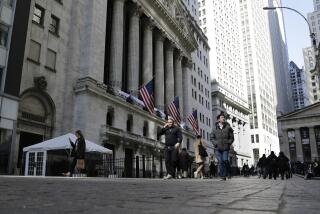Treasuries stage a surprise
- Share via
Three months ago, the conventional wisdom was that the incipient economic recovery had turned the Treasury bond market, typically a haven for nervous investors, into a dangerous place.
But the experts were wrong. In the second quarter, U.S. government securities staged an explosive rally that stunned even ardent Treasury bulls.
Amid fear that Europe’s debt crisis could imperil the global economy’s rebound, potentially sending the U.S. back into a recession, jittery investors flocked to Treasuries. The buying pressure pushed down the bonds’ yields and pushed up their prices, producing juicy gains for investors.
Mutual funds specializing in long-term Treasury bonds returned 14.1% in the latest quarter, easily outperforming all other bond sectors and even besting all stock categories.
The rally -- coming “just when we thought it was safe to get out of the Treasury water,” joked Jim Sarni, managing principal at Payden & Rygel Investment Management in Los Angeles -- accounted for almost all of the sector’s 15.2% total return in the first half of this year. The figures include interest earned as well as changes in the bonds’ market value.
Many investment professionals remain convinced that the day of reckoning for Treasuries and other long-term bonds will dawn -- just not as quickly as they once thought.
Despite a recent string of soft economic reports, they say, the recovery in the U.S. is continuing, albeit more slowly and unevenly than before.
Rather than the V shape many investors had envisioned, the recovery now might look more “square-root-shaped,” said Dave MacEwen, chief of fixed-income investing at American Century funds.
Others, while acknowledging that a feared “double dip” is possible, assume that a second economic contraction would be less severe and shorter-lived than the Great Recession.
If that’s the case, “the next significant move in Treasuries is higher rates,” said Tom Luster, head of investment-grade investing at Eaton Vance.
Even so, he said, “We can have low rates for a considerable period of time.”
Indeed, bond interest rates in the U.S. are unlikely to face any upward pressure from the Federal Reserve, which is expected to keep short-term interest rates near zero until the economy shows significant strength.
No other bond sectors came close to the whopping returns posted by long-term Treasuries in the quarter, but many funds holding other high-quality bonds notched solid gains. Long-term investment-grade funds were up 4%; intermediate-term investment-grade funds rose 2.7%.
Most municipal-bond fund sectors posted total returns of 1% to 2%, before adjusting for the securities’ tax-free status.
But many nongovernment sectors struggled.
As the quarter began, some investors were moving out of fixed-income havens into stocks and other riskier assets. But that trend reversed in late April as investors worried that Greece’s fiscal crisis could spread to other debt-laden European countries, threatening global economic damage.
That sparked a stampede into Treasuries and an exodus from riskier bond sectors such as high-yield securities, emerging-market debt and bank loans made to lower-rated companies.
Still stung by the horror of 2008 and early 2009, when nearly everything but Treasuries plunged in value, many investors remain “very risk averse,” MacEwen said. “They’re looking for safe places to put their money.”
The reversal was especially pronounced in the high-yield category -- funds that hold corporate junk bonds. High-yield funds lost 0.7% in the second quarter overall, after gaining 3.5% in the first three months of the year. Emerging-market debt funds fell 0.9%. Bank-loan funds pulled up the rear with a 1.4% decline.
As for Treasury bonds, many experts doubt interest rates can fall much further without a dramatic worsening of the economy.
Although a “massive economic recovery” that would send yields surging is unlikely, MacEwen said, rates are also unlikely “to go down substantially barring a double-dip recession.”
--
More to Read
Inside the business of entertainment
The Wide Shot brings you news, analysis and insights on everything from streaming wars to production — and what it all means for the future.
You may occasionally receive promotional content from the Los Angeles Times.










